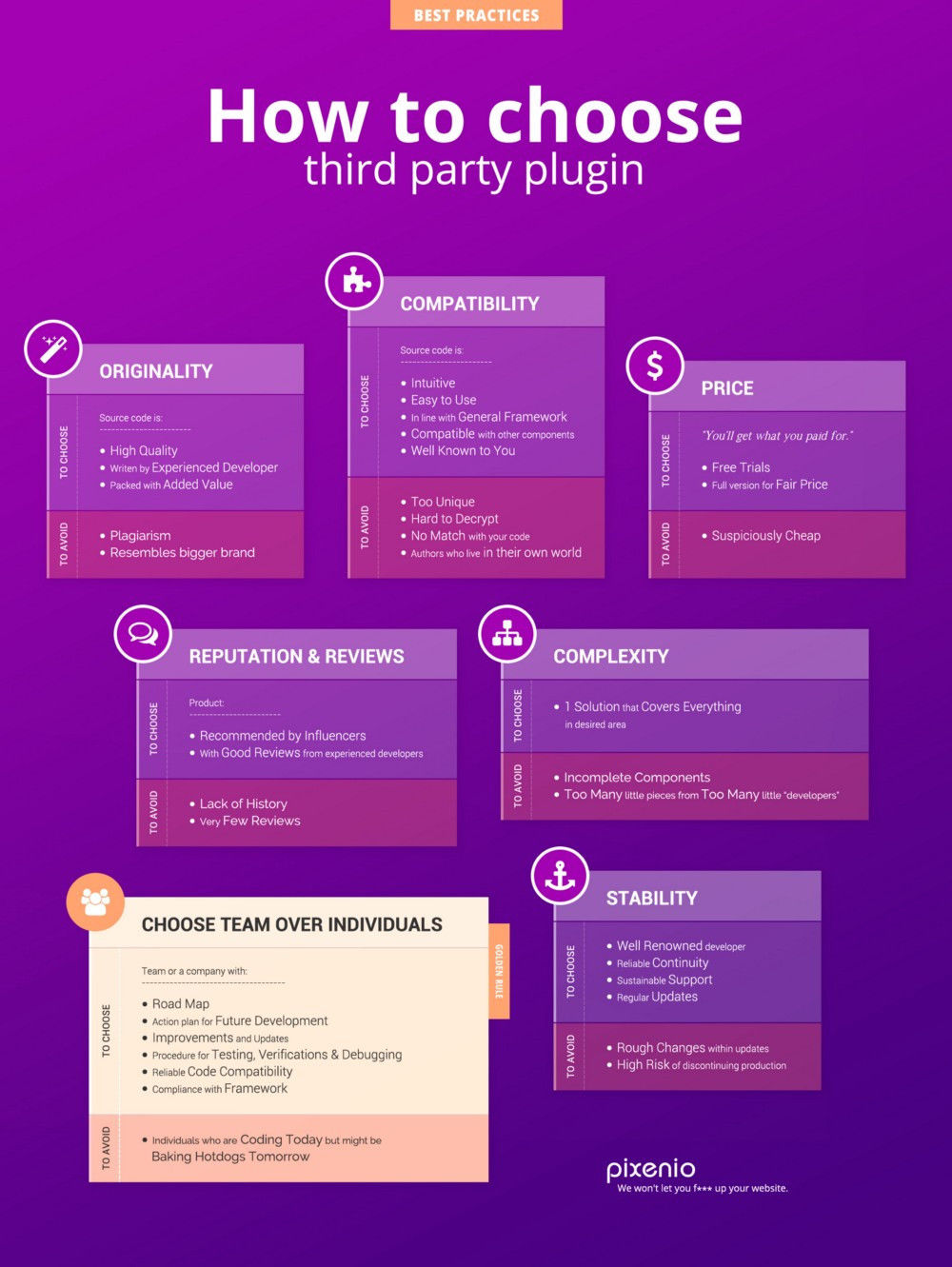Measure twice, cut once. Choosing wrong third party plugin will cost you time and money in the future, not to mention sleepless nights when, suddenly, all you’ve been working on for months, will fall apart…
To avoid this mistake, we’ve implemented Best Practices for choosing third party pieces for Pixenio. It’s a simple step-by-step guide that will help you identify red flags and make smarter choices about who are you going to trust.

How to choose third party library / plugin
(Our Internal Best Practices)
When building Pixenio, our main goal from the very beginning was to make it simple and reliable. Because the chain is only as strong as its weakest link, we knew we had to be extra careful when choosing external components. Luckily, our team of developers and designers have years of experience and can foresee any trouble upfront.
Here’s the list of 6 very basic attributes to consider when choosing third party plugin, library or basically any external part:
1. Originality
To choose: The product that is original and high quality, written by experienced developer, with significant added value by it’s author.
To avoid: Anything that resemble another, perhaps bigger brand/author.
2. Compatibility
To choose: Code that is intuitive and easy to use. Workflow of the code must respect the general framework you’re using. It is compatible with other components and is well known to you.
To avoid: Anything too unique and unfamiliar that will take you ages to decrypt or won’t fit in your, already written, code. Some authors simply live in their own world…
3. Price — Remember: you’ll get what you paid for.
To choose: Products with free trials and fair price for the full version.
To avoid: Anything suspiciously cheap. Always compare various options before making your decision.
Remember that even free products have their price — additional costs you’ll pay in case something goes wrong after implementation.
4. Reputation & Reviews
To choose: Products recommended by influencers and with bad reviews only from people who clearly don’t understand coding.
To avoid: Products from individuals with lack of history and little to no reviews.
5. Complexity
To choose: Complex solution that takes care of the entire area you need to cover
To avoid: Incomplete components. Always avoid using too many little pieces from too many little “developers.”
6. Stability
To choose: Well renowned developer who offers reliable continuity, sustainable support and updates, and has very little risk of cutting-off the production all together. Look in the past to foresee the future.
To avoid: Anything with a history of too rough changes within updates and high risk of discontinuing production.
Golden rule: Choose team over individuals
To choose: Solution developed by a team or a company.
A team of people is more likely to have:
- road map;
- action plan for future development, improvements and updates;
- procedure for testing, verifications and debugging;
- better code compatibility and compliance with framework.
To avoid: Individuals who are coding today but might change their mind and do something else tomorrow.
Bigger your project is, more strict you need to be in following these Best Practices.
Imagine that you’re building your e-shop and you choose some shady, unknown plugin for online orders, just because it’s cheap. Your website will break down after every single update as it’ll lack compatibility with the plugin. Each time you’ll end up with no sales until it’s fixed.
In worst case scenario, the author of the plugin will disappear somewhere to Bahamas after a bug in his plugin had been found. You will have to rebuild your entire website finding another, more reliable plugin for online orders.
Conclusion
Open source web building solutions are amazing. Internet is flooded with either free or very affordable plugins you can install to extend the functionality of your website. They’re easily accessible, customisable, cheap… However you need to be very careful while picking the one that is right for you. Think twice, install once. Not the other way around.
Do you have any more tips for choosing 3rd party parts? Please share them in a comment to help others improve their projects.



Add a Comment